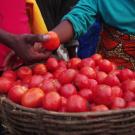This report was published in August of 2019 by the Horticulture Innovation Lab’s Reducing Postharvest Losses in Rwanda project. The report aims to assess the horticulture postharvest landscape in Rwanda and further understand traditional farmer practices in three major agricultural regions of the country, Northern, Southern and Eastern including Kigali City.
Farmer demographics
There were 102 farmer interviewed in the Northern region, 70 interviewed in the Southern region, and 39 interviewed in the Eastern region. In the Northern Region, the gender of interviewed farmers is almost balanced and most respondents live in extended family. In Eastern and Southern Regions, majority of the respondents were male and most respondents live in nuclear family.
Description of crops grown by interviewed farmers
The predominant crops grown in the northern region of Rwanda are beans, maize, green banana, tomatoes and orange fleshed sweet potatoes. In the Eastern Region, the predominant crops grown by the interviewed farmers are tomatoes and chilies. In the Southern region, the farmers interviewed mostly grew tomatoes, followed by green banana, chili.
In the Northern region, 74.1% of reported yield was sold to wholesalers, 18.4% was used for direct consumption by households, 5.3% was sold to intermediaries and only 2.2% was sold to pack houses. In the Eastern region, the majority of chili and tomatoes production were sold to wholesales at 43.5%. 24.1% of the production were sold to intermediaries and 19.2% was exported. In the southern region, most of the production was sold to wholesales at 63.4% while 24.0% of the production was used for intermediaries and 12.5% of them were sold directly to consumers.
Sales
Farmers typically have to wait for a few days for buyers or for the right price before which they can sell their produce. However, there is a trade-off in waiting for too long as the produce starts to rot. On average, tomatoes were kept for 2-3 days, chilies for 1-2 days, green bananas for 0-1 day and orange flesh sweet potatoes for 2-3 days. In the Northern region, the duration between harvest and sales ranged from 365 days for peas to 0 days for coffee and green banana. In the Eastern region the duration between harvest and sales was two days for both chili and tomatoes. In the Southern region the duration between harvest and sales ranged from three days for tomatoes to 1 day for chili, green banana, and pineapple.
Quality grades of high, medium, or low are reported by crop for each region. Grading of harvested crops before selling is a crucial tool that farmers can use to get a premium price for high quality produce. Survey results show that the important crops in each region are usually the ones being graded. The majority of farmers interviewed believe that grading has an impact on selling price. However, the analysis showed that price was independent of grading. On the contrary, the average price of each sold crop is affordable to the buyers.
Farmers Practice: Crop Sales vs Home Consumption (Fresh, Processed or Stored)
The study asked the farmers how much of their harvest, they consumed fresh, how much did they process and how much did they keep for long-term storage. The findings indicate that the farmers sell their harvest rather than storing and processing.
Predominant defects that lower price of crops
Several different types of defects such as decay, damage, pests and other lower the price of crops. In the North, pest damage, moisture loss and decays were common causes of defects. In the East, disease was a common cause of defects. In the South, bad season, bad seeds and damages by pests were leading causes for defects.
Postharvest Extension and When to Harvest
The majority of farmers had received training on postharvest management prior to project intervention. Most of the interviewed farmers reported that they used previous experience to determine when to harvest.
Investment Capacity of farmer
The study found that the sources of financial access range from banks to businesses, own savings, cooperatives, production revenue, savings and lending groups. Nearly 60% of farmers reported being able to get a loan. However the majority of loans are not used for farming activities. The percent of loans used for farming was 25.5% in the Northern region, 10.3% in the Eastern region, and 21.3% in the Southern region.

